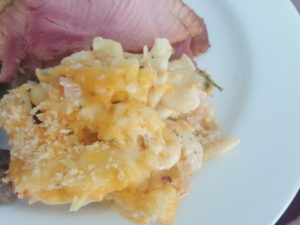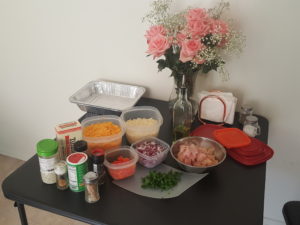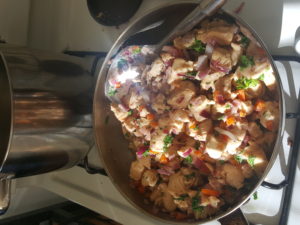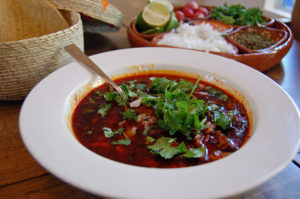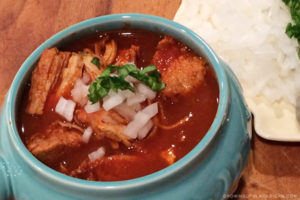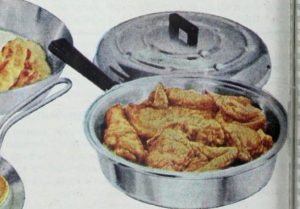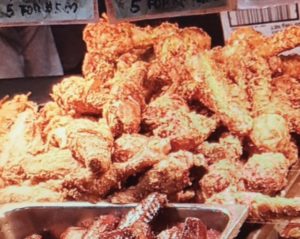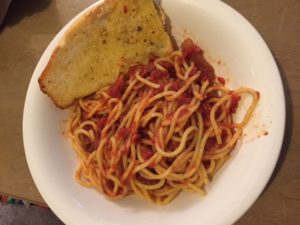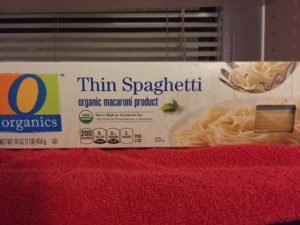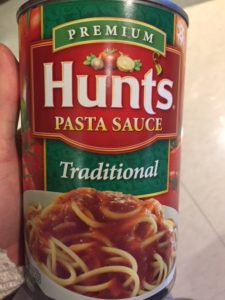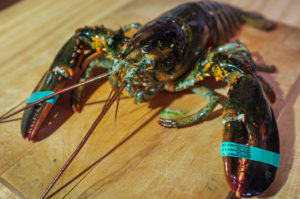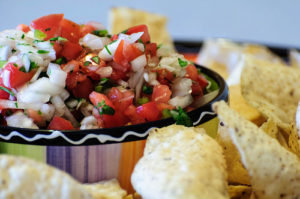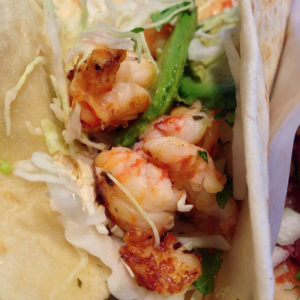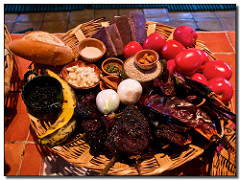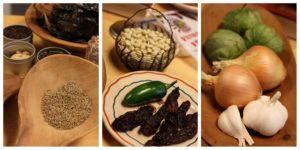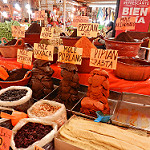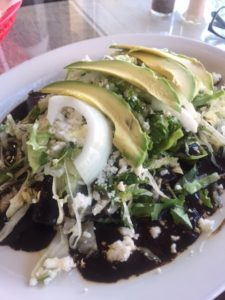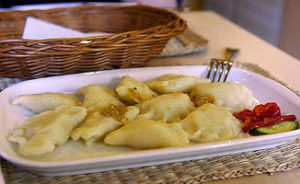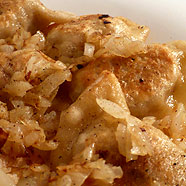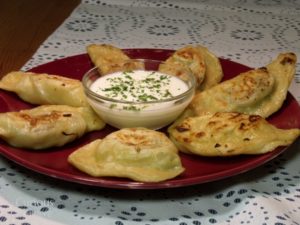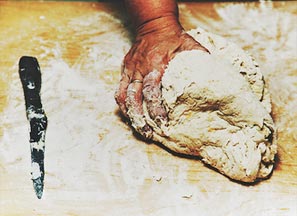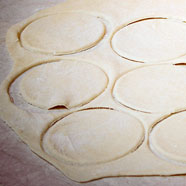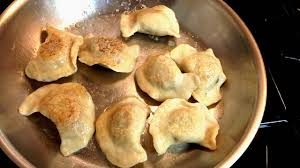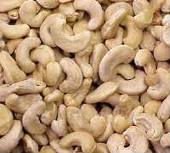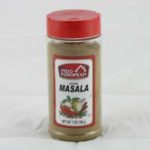The Sopa Verde, which is translated as the green soup, is not really a green soup; it is pasta with a creamy green chile sauce and cheese. It is a dish that my family and I have enjoyed since I can remember. This dish was always prepared during the holidays during Thanksgiving and Christmas, it is a side dish but we love it and we enjoy it often as a main dish. I asked my mother where this recipe came from and she said she was 99% sure that it came from one of my father’s sisters. My dad came from a big family of 12 siblings, the aunt that made the Sopa Verde was Tere short for Teresa, and she passed away 8 years ago. All of my aunts, there are 6 six of them, are all good at cooking. I have tasted everyone’s cooking and it has all been delicious. Which makes sense because they all grew up learning to cook in the same kitchen from my Grandmother, but when you ask each of my aunts who cooks the best out of all the sisters they will all have the same answer “tu tia Tere,” translation, “ your aunt Tere.”
During the holidays when I was a little girl one of the things I looked forward to was eating that Sopa Verde, we would look forward to it all year long. For the longest time I thought I was the only who loved the dish the most, but as I got older I learned that all of my cousins and aunts and uncles were thinking the same thing. For Christmas every year we would go to Ensenada, Mexico. Ensenada is about 2 hours away from the Tijuana Border. It is a beautiful trip during the day and even more beautiful if the sun is setting, you have the ocean view all the way to Ensenada. As you arrive to Ensenada you can see all the fishing boats, this always makes me think of my dad and my Grandfather. My Grandfather owned a few of the fishing boats and my dad was one of the fishermen so they used be out fishing for months at a time. My parents are both from Ensenada and we would always stay at my mother’s only sisters’ house through our Christmas Vacation. We would celebrate with my mother’s family on Christmas Eve, and then on Christmas day we would go to my father’s parent’s house. We would get there at around 4 or 5 in the evening by that time most of the family was there. The house was so full of people at least 50 people, all immediate family. I was always so overwhelmed with my dad’s huge family but also happy to see them all. The kitchen always seemed to be the most popular room. My aunts were always there forming an assembly line to be able to feed the whole family, my mother would always join in and help. It was fun watching all the sisters together helping each other cook and the interesting part to me was that even though it was a lot of hard work cooking all that food and serving everybody they always looked so happy and enjoying themselves laughing and talking the whole time. For Christmas the Sopa Verde accompanied the Tamales, beans, and a carrot salad and it was first introduced to the family (dad’s side) on Christmas Eve dinner by my aunt Tere. For Thanksgiving the Sopa Verde became part of our Turkey dinner and it goes great with everything. When I asked my mother and my aunts where my aunt discovered this recipe, none of them were too sure or could remember, but they said that she must have picked it up from one of the parties she attended. My aunt was notorious for attending parties, birthdays, wedding, etc. at least one every weekend. My aunt was the wife of a principle to a middle school, so she was invited to many events. She must have picked up the recipe from one of the thousands of parties she attended. My aunt had given my mother the recipe, and my mother introduced it to her side of the family, and now they are all obsessed with this dish, having no Sopa Verde for Thanksgiving dinner would be like having no turkey, in our family it is very important. My mom’s sister and cousins have all learned how to make Sopa Verde. I’m pretty sure other families make this dish on for the holidays as well. Although, I have never seen it in anybody else’s home for Thanksgiving or Christmas dinner, but my says she has over heard someone in the market saying “don’t forget the green noodles to make the green pasta,” this could mean anything just because they said green doesn’t mean it was our Sopa Verde, they could have meant a pesto pasta or maybe they use green food coloring, I just don’t think it was our Sopa Verde, but my mother seems to think so. Another time I was describing it to a co-worker and she said she thought her family makes it too, she said the ingredients sounded familiar. It’s possible, but I don’t think so.
This is the way my mother prepares it;
- She boils thin curly egg noodles which she changed since last year, she used the thicker noodles before, in my opinion the thinner ones are better
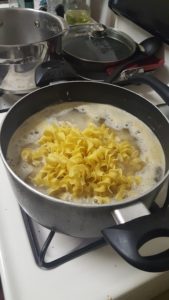
- Then she drains the noodles once their cooked, and starts making the sauce.

- For the sauce she uses canned green chiles, and it is the quicker version of the recipe. The original recipe calls for fresh roasted peppers. My aunt always took the time to roast the green chile peppers on an open flame, then peel them and deseed them (just like chile rellenos) It does come out a bit spicier, which I prefer and it of course it does the fresh peppers do give more flavor, but if you don’t like spice then go with the canned version or you can add a little more sour cream it will still come out good.
- Next you put the roasted chiles in the blender along with about one cup of sour cream, 1 table spoon Knorr bouillon powder a little salt, and pepper, and blend. My mother never uses measurements, she’s been making it forever so she just knows the right amount, and she’s constantly tasting just see to if she needs to add a little more of anything, that is very important.
- You put your noodles in your baking bowl, we usually use the big disposable aluminum pans since were making a big portion. Before you add the sauce you cut pieces of one stick of butter, you don’t have to use the entire stick, and put them on top of the past. Once the sauce tastes perfect to your liking you pour the green chile creamy sauce all over the noodles.
- Finally you sprinkle your, either mozzarella, or jack
 cheese, we always mix both cheeses, but either one will come out good. Cover with foil and bake for about 15 to 20 minutes or until cheese has melted.
cheese, we always mix both cheeses, but either one will come out good. Cover with foil and bake for about 15 to 20 minutes or until cheese has melted.
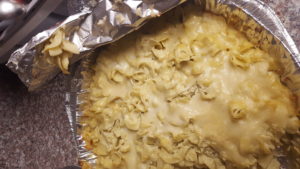
I tried to find a recipe online to see if there was one out there, but I really couldn’t find anything. The closest recipe I found was one from a restaurant called Pinto Restaurant & Salsa Company, the recipe calls for green roasted chiles, but they add chicken, parmesan cheese and garlic which make it in my opinion a little more Italian style. Another recipe I found was a Green Chile-Cilantro Pesto Sauce (Pasta), I love a pesto sauce and it looks really good but not the same.
The history of pasta is not very easy to trace. I looked up some of the origins of pasta and most would think that it originated in Italy since they are famous for it. Historians claim that it was the Arabs, especially from Libya, that were the first to bring pasta along with spinach, eggplant and sugar cane. Pasta was introduced to Italy during the Arabs conquest in Sicily, which also influenced Italian dishes. A common belief about pasta is that it was brought to Italy from China by Marco Polo during the 13th century. Since Polo’s original work doesn’t exist anymore, the book relies on stories retold by various authors. Oh and did you know there are over 500 different types of pasta from shapes to colors, I found a list of the pasta variations that I thought was pretty interesting to see.
The history of the green chile is the pepper, member of the genus Capsicum part of the night shade family of flowering plants. It is related to the tomato and the potato, that’s strange they are so different. The red and green peppers are fruits from the same plant picked at different times. Most chiles come from New Mexico; it is considered the Chile capitol of the world. Chile peppers are good sources of vitamin A, B, and C. They are high in fiber, phytonutrients, and Capsaicin. They also help boost your metabolism and the nutrients help stimulate weight loss.
Chiles were said to have originated back in 7000 B.C. Mexicans used the chiles to spice up and give their food flavor. The green chile was brought to the U.S by none other than Christopher Columbus, the very same Columbus who discovered America in 1493. Christopher mistook the chile for black pepper and that is how the name “chile pepper” came to be. Chile seeds were brought to North America for cultivation. Cross breeding of chile peppers started in 1888 and peppers evolved into a variety of chile peppers.
They say mozzarella cheese was first made when cheese curds accidentally fell into a pail of hot water in a cheese factory near Naples and thereafter the first pizza was made. The truth is that new cheeses are often created when mistakes happen, so there may be truth.
Mozzarella originated in Italy near Naples from the milk of water buffalos, because it was not made from pasteurized milk and because there was little or no refrigeration the cheese would go bad very quickly therefore, it did not leave the southern region of Italy near Naples where it was made. As cheese technology, refrigeration systems developed the cheese spread to other areas of Italy. Today two types of mozzarella are produced in the U.S, low moisture and high moisture.
David Jacks is the man said to have been responsible for the name Monterey Jack cheese. David Jacks was a Monterey, California, businessman in the 1800s. However, history shows that it actually was based on a recipe for queso del país “country cheese”, brought to California by Franciscan monks in the 1700s. David Jacks did increase the popularity and demand for the cheese when he began shipping it to San Francisco. The name Monterey Jack came about because production was based in Monterey County, California. Eventually other areas named the cheese for their region, as with Sonoma Jack (Sonoma County, California), and now Monterey Jack cheese is made in other parts of the United States.
SOURCES:
El Pinto Restaurant, Green Chile Chicken recipe,
http://www.elpinto.com/recipes/green-chile-chicken- pasta, accessed on 12/6/16
By Ihvhope, Green Chile-Cilantro Pesto Sauce (Pasta) recipe,
http://www.food.com/recipe/green-chile-cilantro-pesto-sauce-pasta-301899, accessed on 6 Dec. 2016
Julia, “Pasta Is Not Originally From Italy”, Today I Found Out, June 3, 2011
http://www.todayifoundout.com/index.php/2011/06/pasta-is-not-originally-from-italy/, accessed on 6 Dec. 2016
Avey, Tori, “Uncover the History of Pasta”, The History Kitchen, July 26, 2012
http://www.pbs.org/food/the-history-kitchen/uncover-the-history-of-pasta/, accessed 7 Dec. 2016
Maister, Kathy, “Different Types of Past” Start Cooking,
http://startcooking.com/different-types-of-pasta, accessed on 7 Dec. 2016
From Wikipedia,
https://en.wikipedia.org/wiki/List_of_pasta, accessed on 7 Dec. 2016
Diaz, Eddie, “The History of Green Chile”, Diaz Farms, May 25, 2013
http://diazfarms.com/chile-history/the-history-of-green-chile, accessed on 7 Dec. 2016
Origin of Chili,
http://www.chilly.in/origin_of_chili.htm, accessed on 7 Dec. 2016
Mozzarella History, La Bella Mozzarella, 5/15/2012
http://www.labellamozzarella.com/MozzarellaHistory.htm, accessed on 7 Dec. 2016
Tyler-Herbst, Sharon and Herbst, Ron,” Monterey Jack”, The Food Lover’s Companion, Barron’s Educational Series, Inc. 2007, http://www.foodterms.com/encyclopedia/monterey-jack/index.html, accessed on 7 Dec. 2016


